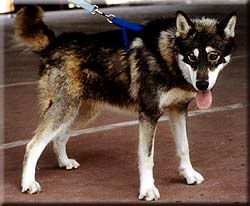
Wildside
Endangered Species & Wild Animals
All content © by Diana L. Guerrero unless otherwise noted and may not be reprinted without prior written permission. All rights reserved. Click here for reprint permissions and fees.
Wildside Explores Wolf Dogs (Canine Hybrids)
Interested in canine hybrids, considering obtaining one, or already entrenched in ownership of an animal that is too complicated for your lifestyle? This article will touch on different issues surrounding wolf dogs also known as wolf dog hybrids. There are seven parts to this comprehensive wolf dog series click here to start at the beginning.
Canine
Hybrids: (Part 5 of 8)
Issues Surrounding The Wolf Dog
Photos Copyright © By Monty Sloan & Jill Moore Porter.
Wolf Dog Issues: Roll over photo with mouse for details on this wolf dog. |
 |
WOLF DOG ISSUES
Sanctuaries overflowing with these animals, zoo personnel dealing with owner calls for assistance or placement, and continued devaluation of the wolf species are just some of the negative impacts on the wolf that come from the trade of these hybrids. However it is the hybrid attacks that the general public hears about--and remembers.Wolf Dog Hybrid Attacks
Animal attacks of all types are in the news but it is the hybrid attacks that throw negative media attention8 on the wolf. In a recent program on animal attacks a "wolf" was blamed for grabbing a child from the backyard of a home near the woods. Only later in the episode was it revealed that the animal was actually a wolf dog. Such stories are only remembered as "a wolf" was responsible. The main argument that comes up in the defense of the wolf dog hybrid is that there are more dog attacks than wolf dog attacks.There are 4.7 million reported dog bites annually and many more that are not reported. Although dog bites are a concern, the breeds in the dog bite-related fatalities should raise alarm bells. Only 25 or so different breeds have been involved in dog bite-related fatalities over the past twenty years. Some show up consistently at the top of that list.
For the time period of 1979-1998 the top five dog breeds that were involved in dog bite-related fatalities were pit bulls, rottweilers, German shepherds, Siberian huskies, and wolf dogs. In addition, the wolf dogs top the dog bite-related fatality list for the known crossbred dogs.9
So just how many wolf dogs are there in the United States? Figures vary widely. In 1994 the number of wolf dogs estimated by the United States Department of Agriculture was 300,000.10 However, in a more recent state-to-state survey (conducted by a wolf dog group) the estimated total numbers were half that (150,000) in 1998.11
Does this indicate a higher percentage of attacks within their smaller population numbers--and within the bigger picture? Perhaps. The issue gets more disconcerting when you notice the more intricate details. wolf dog crosses can include breeding with pit bulls, chow chows, and dobermans. Most agree that these mixes are a bad idea.
Wolf dogs are more commonly bred with malamutes, huskies, and German shepherds. Upon closer inspection of the dog bite-related fatality list you can see that the breeds being bred for wolf dogs are those animals that appear in the top fatality spots of the list!
There are many factors to why dogs bite, these include: heredity, sex and reproductive status, early experiences (or lack) of socialization and training, medical and behavioral health, environment and the quality of ownership and supervision.
The solution lies through the education and training of potential pet owners on certain topics. Training for pet ownership should be mandatory. Some of the topics should include: canine behavior, care and management; what constitutes adequate food, water, shelter and veterinary care; how to properly socialize, exercise, and train the animal; long term financial responsibility; licensing and permits; leash laws, containment and fencing requirements; bite prevention; and mandatory pet sterilization.
Behavior Problems
Wolf dog hybrid ownership poses and amplifies some unique challenges. For instance, howling is a means of communication. Where, when, and of what duration their wolf dog howls is a challenge that faces some wolf dog owners. However that is one of the more minor problems.Wolf dogs can also tend to be very mouthy with human bodies and they are high energy and active animals which can create a dilemma for a novice owner. This behavior and many others have to be addressed skillfully and at an early age.
For instance, these animals can display predatory behavior and possessiveness or aggression that is highly escalated in comparison with the household dog. This can be exhibited in a variety of situations and over a diversity of items.
Even puppies can growl aggressively over simple situations to establish boundaries, and as they grow, can quickly snap, causing injury or the destruction of property. There are many red flag situations where aggression may surface.
Cyclic aggression can be exhibited due to hormonal influences during the breeding season. Although some wolves can show care giving behavior towards children, not all do. More often they display predatory behavior. Children can trigger stalking behavior and worse, just through their normal movements of play and screaming.
Territorial behavior and aggression toward unfamiliar dogs can be problems too. Once the wolf dog matures, it may not get along with dogs of the same sex. Attacks or challenges can occur as the animal matures and begins testing and attempting to achieve dominance. There are a wide variety of triggers that are outlined well by wolf dog specialist Monty Sloan at another site.12
Other natural behaviors that pose challenges to the inexperienced owner are denning activities and the marking of territory. (Denning is the act of digging a den.) This causes destruction to the home environment both inside and out. Tunnels through the yard, the marking of furniture, perimeter areas, and other belongings are common.
In the home the devastation can be unbelievable. Bright, curious and active, many wolf dogs become adept at opening cabinets, the refrigerator, and more. This activity results in the destruction of items the owner thought were safe. Property is destroyed and many of these animals end up ostracized from the living quarters and isolated because of it.
To see the wide scope obliteration wolf dogs perpetuate in a home is horrific. Often there are no places left to sit. The flooring can be torn up or soiled (marking behavior) so severely that it has to be removed. Even the walls and hangings can be destroyed!
The yard often begins to look like a construction site with little foliage, massive holes and scattered debris. Guests also become reluctant to visit due to the state of the home and the presence of these active whirlwinds.
These critters are swift and adept at grabbing and confiscating your items, or those of others. This is another fun past time that visitors do not find amusing. If the item grabbed is an article of clothing like a purse with important identification, a hair tie or necktie, it can be even more distressing.
These animals are not truly domestic nor are they truly wild. As a result, most cannot be trained like your normal domestic companion. This is not to say that they are not trainable--any animal can be trained. However they require early work, understanding of their natural behaviors gleaned from their wolf heritage and more progressive methods of training.
Most new owners of these animals cannot or do not know how to address these training needs. Instead they rely on aversive techniques, force and pain inflicting tools; these tactics are not advisable. wolf dog owners need to find and work with trainers knowledgeable about wolf dog hybrids and who use positive training techniques.
Wolf dog hybrids hit their prime at sexual and psychological maturity, which can vary. Although problems can occur at any time, this is where it can get dangerous. The predicament that seems to rear up consistently is challenging the owner or other household members.
Wolf dogs do a lot of testing. Although there are exceptions, more risk of attack or challenge is present around these maturation times. The animals don't just "turn" but are following a behavioral predisposition related to a natural hierarchical climb within the wolf species. I personally know of challenges as early as two years and as late as seven, but these time windows are as variable as the wolf dogs and the environments they are in.
Like the game of Russian roulette you cannot tell when the chamber is loaded, or when it isn't, with a wolf dog. The risk is there, it might just not have exhibited itself yet. Most new owners of wolf dogs are oblivious to what the etiquette and rules are within the hierarchy that the wolf dog perceives; this is what gets them into trouble.
Wolf Dog Hybrids Part Six: Wolf Dog Hybrid Veterinary Concerns
Diana L. Guerrero, author of this series, is an animal behavior consultant and animal training coach with extensive experience in many areas of the animal world. She first began working with wolf-dogs in 1979 and discourages the ownership and breeding of these animals.




